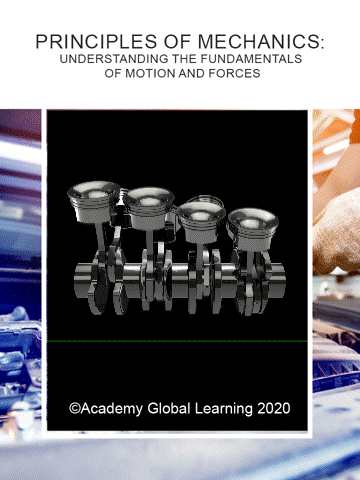

This book developed by ©Academy Global Learning 2020
All rights reserved under ©Academy Global Learning 2020. No part of this publication may be reproduced, stored in a retrieval system, or transmitted in any form or by any means, electronic, mechanical, photocopying, recording, or otherwise, without the prior written permission of the copyright owner.
Designed By:
Christian Alas
Created and illustrated By:
Angelo Romero and Camilo Sanabria

Principles of Mechanics: Understanding the Fundamentals of Motion and Forces
Introduction: Mechanics is a branch of physics that deals with the study of motion and forces. It provides a framework for understanding how objects move, interact, and respond to various external influences. In this article, we will explore the key principles of mechanics, including Newton’s laws of motion, torque, power, work, and the significance of friction in mechanics.
Definition of Mechanics: Mechanics is the scientific discipline that focuses on describing and analyzing the motion and forces acting on objects. It encompasses the study of both the macroscopic world, involving everyday objects, and the microscopic world of particles and atoms. By applying fundamental principles, mechanics enables us to explain and predict the behavior of objects in motion.
– 2 –

– 3 –
Newton’s Three Laws of Motion: Newton’s laws of motion form the foundation of classical mechanics. These laws describe the relationship between the motion of an object and the forces acting upon it.
1. First Law: The law of inertia states that an object at rest tends to stay at rest, while an object in motion tends to stay in motion unless acted upon by an external force.
2. Second Law: The law of acceleration states that the acceleration of an object is directly proportional to the net force acting on it and inversely proportional to its mass. It can be expressed as F = ma, where F is the force, m is the mass, and a is the acceleration.
3. Third Law: The law of action and reaction states that for every action, there is an equal and opposite reaction. In other words, the forces between two objects are always equal in magnitude and opposite in direction.
Torque, Power, and Work: Torque, power, and work are fundamental concepts in mechanics that help us understand rotational motion and the transfer of energy.
Torque is the rotational equivalent of force and is defined as the product of the force applied and the perpendicular distance from the axis of rotation. It determines how effectively a force can cause an object to rotate.
– 4 –

– 5 –
Power is the rate at which work is done or energy is transferred. It measures how quickly a force can accomplish a certain amount of work. Power can be calculated by dividing the work done by the time taken to do it.
Work is defined as the transfer of energy that occurs when a force acts upon an object and displaces it in the direction of the force. The work done is given by the product of the force applied and the displacement covered.
Friction and Its Importance in Mechanics: Friction is a force that opposes the relative motion or tendency of motion between two surfaces in contact. It plays a crucial role in mechanics, influencing the behavior of objects in motion.
Coefficient of friction is a measure of the frictional force between two surfaces. It varies depending on the nature of the surfaces and can be classified into two types: static friction and kinetic friction.
– 6 –
Static friction acts on objects at rest, preventing them from moving. It is characterized by the maximum force that must be overcome to set an object in motion. Once the object starts moving, kinetic friction comes into play, which opposes the object’s motion.
Understanding friction is essential in various real-world applications, such as designing efficient vehicles, controlling the movement of machinery, and ensuring stability in structures.
Conclusion: Mechanics provides us with the principles to comprehend and analyze the motion and forces acting upon objects. By understanding Newton’s laws of motion, torque, power, work, and the role of friction, we can explain and predict the behavior of objects in motion. These principles find applications in numerous fields, from engineering and physics to everyday activities, making mechanics a fundamental aspect of our understanding of the physical world.
– 7 –


